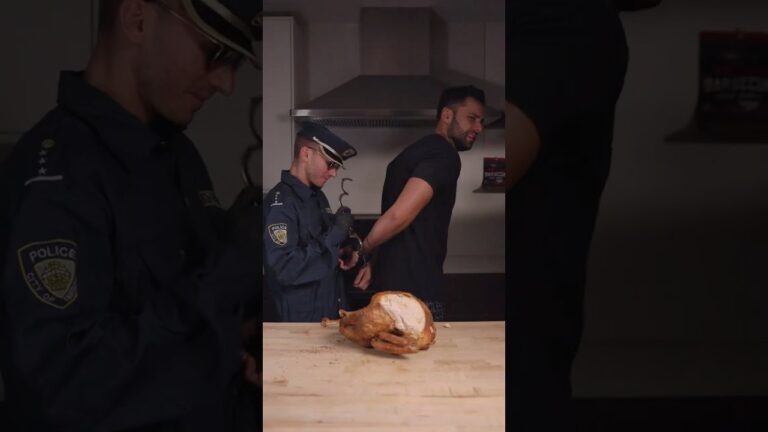[ad_1]
Carving a turkey can seem daunting, but with the right tools and a systematic approach, you can carve it like a pro. Here’s a detailed guide:
I. Preparation is Key:
-
Resting Period: After roasting, let the turkey rest for at least 20-30 minutes (and up to 45 minutes for a large bird) before carving. This allows the juices to redistribute, resulting in more succulent meat. Cover loosely with foil to keep warm.
-
Carving Station: Prepare a clean and stable carving board. A board with a well or grooves is helpful for collecting juices.
- Tools:
- Sharp Carving Knife: A long, thin-bladed carving knife (8-12 inches) is essential. A granton edge (dimples along the blade) helps prevent the meat from sticking. Make sure it’s sharp! Use a honing steel before you begin.
- Carving Fork: A sturdy carving fork with long tines is needed to secure the turkey while carving.
- Serving Platter: Have a serving platter ready to receive the carved meat.
- Optional:
- Kitchen Shears: Useful for trimming the turkey and removing the backbone (if applicable).
- Basting Spoon: For collecting and drizzling juices over the carved meat.
II. The Carving Process:
-
Positioning: Place the turkey breast-side up on the carving board, with the legs facing towards you.
-
Leg Removal:
- Finding the Joint: Locate the point where the thigh connects to the body. Gently pull the leg away from the body to help find the joint.
- Slicing: With the carving knife, cut through the skin and meat connecting the leg to the body. Apply pressure to the leg to expose the joint.
- Severing the Joint: Once the joint is exposed, use the tip of the knife to sever the connective tissues. The leg should now easily detach. Repeat on the other side.
-
Thigh and Drumstick Separation:
- Place one leg on the carving board.
- Locate the joint connecting the thigh and drumstick.
- Slice through the skin and meat to expose the joint.
- Sever the joint with the tip of the knife.
-
Slicing the Thigh:
- Hold the thigh firmly with the carving fork.
- Slice the thigh meat parallel to the bone, creating even slices.
- Rotate the thigh as needed to carve as much meat as possible.
-
Slicing the Drumstick:
- Hold the drumstick by the end.
- Slice the meat down the side of the drumstick, rotating to remove all the meat.
- Alternatively, you can hold the drumstick upright and slice downwards, rotating as you go.
-
Wing Removal:
- Locate the joint where the wing connects to the body.
- Pull the wing away from the body.
- Cut through the skin and meat around the joint.
- Sever the joint to detach the wing. Repeat on the other side.
- Wings can be left whole or the wing tip can be removed at the joint.
-
Breast Carving (Horizontal Cut):
- Initial Cut: Locate the breastbone (sternum) in the center of the turkey. Make a long, horizontal cut along the breastbone, from the neck cavity to the end of the breast. Cut deep, almost to the rib cage.
- Following the Rib Cage: With the carving fork holding the turkey steady, insert the knife along the side of the breastbone and slice downwards, following the contour of the rib cage. The goal is to remove the entire breast in one large piece. Repeat on the other side.
- Slicing the Breast: Place one breast piece on the carving board, skin-side up.
- Slice the breast crosswise into even slices (about ¼ to ½ inch thick), angling the knife slightly for longer slices.
-
Breast Carving (Vertical Cut):
- Initial Cut: Make slices parallel to the breastbone, starting from the outside and working inwards.
- Angling: Angle the knife slightly towards the center of the breast to create even slices.
- Releasing: Once you’ve sliced down to the bone, make a horizontal cut along the base of the slices to release them from the breast.
-
Arrangement:
- Arrange the carved meat attractively on the serving platter.
- Separate the white meat (breast) and dark meat (leg and thigh).
- Garnish with fresh herbs like parsley or thyme, if desired.
- Gravy and Juices:
- Pour the accumulated juices from the carving board and roasting pan into a gravy boat.
- Serve the gravy alongside the carved turkey.
III. Tips for Success:
- Sharp Knife: A dull knife is dangerous and will tear the meat. Sharpen your carving knife before you start.
- Practice: Carving a chicken beforehand can help you get comfortable with the process.
- Don’t be Afraid to Use Your Hands: Clean hands are fine for positioning the turkey and feeling for joints.
- Patience: Don’t rush the process. Take your time and focus on making clean, even slices.
- Use the Juices: The juices from the carving board are full of flavor. Be sure to collect them and serve them with the turkey.
- Leftovers: Save the carcass to make turkey stock.
- Presentation: Arrange the carved meat attractively on the serving platter.
By following these steps, you can confidently carve a turkey and impress your guests.
[ad_2]

